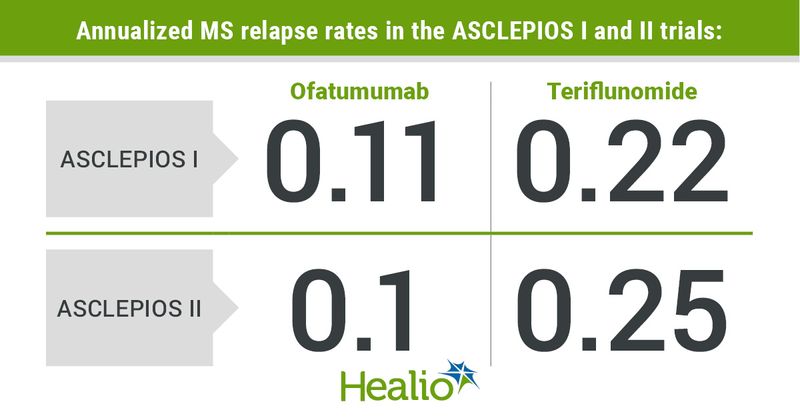ASCLEPIOS trials: Ofatumumab reduces relapse rates in MS
Among patients with multiple sclerosis, ofatumumab was associated with lower annualized relapse rates than teriflunomide, according to a pair of phase 3 randomized controlled trials published in The New England Journal of Medicine.
Ofatumumab (Novartis) is a subcutaneous anti-CD monoclonal antibody that selectively depletes B cells. Teriflunomide (Sanofi Genzyme) is an oral inhibitor of pyrimidine synthesis that lowers T-cell and B-cell activation, according to Stephen L. Hauser, MD, director of the University of California, San Francisco Weill Institute for Neurosciences, and colleagues.

In the ASCLEPIOS I and II clinical trials, 1,882 patients with relapsing multiple sclerosis in 37 countries were randomly assigned to receive 20 mg of ofatumumab every 4 weeks after 20 mg loading doses at days 1, 7 and 14, or 14 mg of teriflunomide daily. Patients received treatment for up to 30 months.
Hauser and colleagues found that after a median of 1.6 years, the annualized relapse rates in ASCLEPIOS I were 0.11 in the ofatumumab group and 0.22 in the teriflunomide group (difference = –0.11; 95% CI, –0.16 to –0.06). In ASCLEPIOS II, the rate was 0.1 in the ofatumumab group and 0.25 in the teriflunomide group (difference = –0.15; 95% CI, –0.2 to –0.09).
Pooling the trial results together, the percentage of patients with worsening disability at 3 months was 10.9% among ofatumumab recipients and 15% among teriflunomide recipients (HR = 0.66; P = .002). At 6 months, that percentage was 8.1% in the ofatumumab group and 12% in teriflunomide group (HR = 0.68; P = .01).
In addition, the percentage of patients with improvement in disability at 6 months was 11% in the ofatumumab group and 8.1% in the teriflunomide group (HR = 1.35; P = .09). The number of gadolinium-enhancing lesions per T-weighted MRI scan, the annualized rate of lesions on T2-weighted MRI, and serum neurofilament light chain levels — but not the change in brain volume — followed the same pattern as the annualized relapse rate, the researchers said.
Injection-related reactions occurred in 20.2% of ofatumumab recipients and 15% of teriflunomide recipients, who received placebo for this part of the trial, according to the researchers. Serious infections occurred in 2.5% of ofatumumab recipients and 1.8% of teriflunomide recipients.
Hauser said that the results are part of a paradigm shift in MS that has occurred in recent decades.
“While there is not yet a cure, a generation ago MS patients typically became cane- or crutch-dependent within 15 or 20 years, but now they often are spared from significant disability,” he said in a press release. “The improvement in MS treatment, especially with drugs that specifically target B cells, is one of the great success stories of medicine."
According to Novartis’ website, the FDA is expected complete its review of ofatumumab’s supplemental biologics license application in September.
Editor’s note: This story was updated to include the drugs’ generic names to avoid reader confusion.

